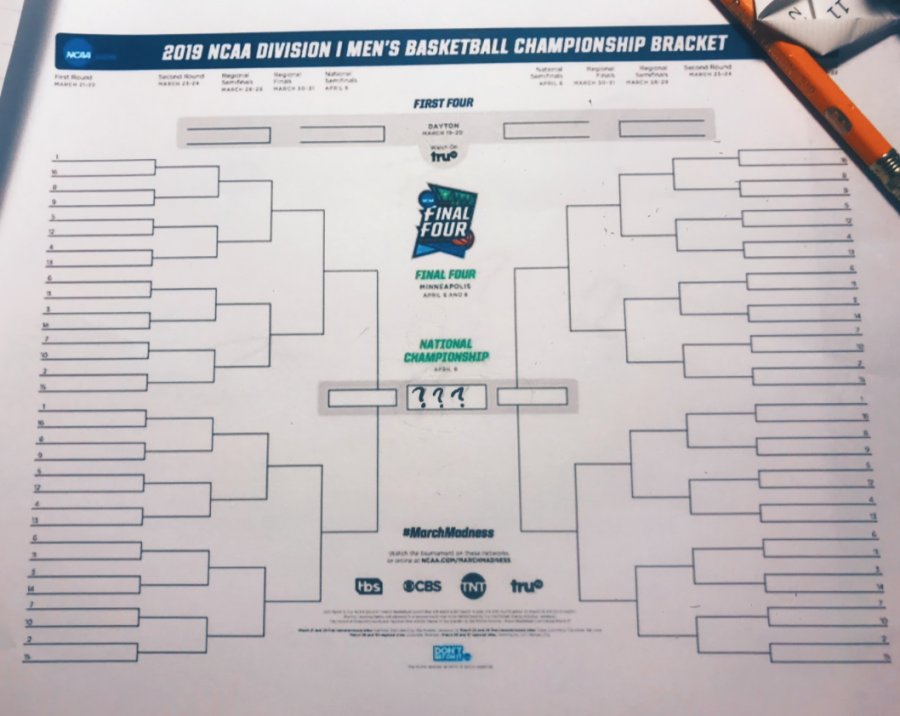Six Tips to Help You Succeed in Your March Madness Bracket Pool
The NCAA Division I men’s basketball tournament, also known as March Madness, will begin on March 19 and conclude with the championship game on April 8.
March 17, 2019
March Madness is back. Over the next few weeks, people throughout the United States will experience excitement, stress, jubilation, and misery. There will be the emergence of stars, upsets that shake the nation, endless highlights, buzzer beaters, Cinderella teams, and, hopefully, no blown out shoes.
Millions of people will disburse their hard-earned money for an entry fee into a March Madness bracket pool, and then spend hours researching, discussing, and watching the NCAA Division I men’s basketball tournament. According to a 2017 report by Wallethub, a personal finance website based in Washington D.C., corporate productivity losses during March Madness amount to $6.3 billion per year due to employees becoming engrossed in the tournament.
Being one of the largest, exciting, and nerve-racking events in all of sports, the NCAA Division I men’s basketball tournament absorbs millions of people each year. With substantial time spent filling out and following brackets, people who lose to their friends, family, or co-workers leave the tournament feeling miserable. However, by following these six tips, you may find success in your bracket pool.
We can not ensure that following these tips will lead to a successful bracket; however, following these tips will increase your chances of crafting a winning bracket and having a more enjoyable March Madness.
1. When in doubt, pick the higher seed to win
Whether or not you choose to do research or just pick which team has the better mascot, it is always a good idea to select the higher seed when you are having trouble deciding between two teams. The process of choosing the team with the better seed (lower numbers are better) to win each game is known as going “all chalk.” This strategy is relatively unadventurous, and it’s always fun to cheer for the underdogs, however, going “all chalk” is a safer play than blindly attempting to predict upsets and Cinderella teams. Although this strategy seems obvious, many people forget that picking the higher seed is a great way to increase your chances of having the best bracket.
2. Choose either a No. 1, No. 2, or No. 3 seed to win the championship
Since 1985, when the NCAA first expanded their tournament to the 64 team tournament we know and love today, a No. 1 seed has won the tournament 21 of 34 times. That’s over 60%! No. 1 seeds have the easiest route to the championship as they have almost a guaranteed pass to the Sweet Sixteen. If you choose not to pick a No. 1 seed, it is in your best interest to keep your champion within the No. 2 and No. 3 seeds. The No. 1, No. 2, and No. 3 seeds have combined for 30 national championships. Not choosing a No. 1, No. 2, or No. 3 seed as your champion will significantly decrease your chance of a victory in your bracket pool.
3. Pick at least one 12-5 upset
The No. 5 seed versus No. 12 seed matchup is well-known for almost always having at least one upset per tournament. In fact, there have only been five years in which all No. 5 seeds beat their No. 12 seed counterparts. Why is this such a smart upset to pick? Because it’s safe! If you predict incorrectly and pick a No. 12 seed that loses, you are not likely to lose out on many points. You probably will not lose many points due to the hard schedule that the No. 5 seed has. The winner of the 12-5 is matched up with the winner of the 13-4 game which is almost always the No. 4 seed. This is a tough matchup for the No. 5 seed and will likely bail you out if you chose that five seed to lose. Finally, if the No. 5 seed does beat the No. 4 seed, they will likely have to face a No. 1 seed, which should end their tournament run. The upside of picking a few 12-5 upsets is safe and can help launch your bracket to the top.
4. Know your scoring system
The scoring system of your bracket is essential to what strategy you should use to pick your games. If you are using the traditional 1-2-4-8-16-32 point system that many popular sites such as CBS and Yahoo Sports use, then picking a lot of upsets is not to your advantage. For each game chosen correctly, this system awards one point per game in the first round, two points per game in the second round, and so on. For example, say you believe that a certain No. 2 seed will not perform well. So you pick them to get upset in the first round. If you are right, you will get one point that most people in your bracket group won’t get. However, with the standard scoring, this one point is basically useless due to the point spike in later rounds. The downsides of picking that No. 2 seed to lose are much greater. If that No. 2 seed goes on to the Elite Eight, you would miss out on seven points (points for rounds 1-3). Risking a pick for the upside of one point is not worth the potential deficient in points you could receive if you’re wrong. However, if you are in a scoring system that gives seed bonuses, then picking risky upsets is a crucial thing that you need to do in order to win. Before you build your bracket, it is crucial that you review your bracket scoring system. Getting a grip on your scoring system will significantly improve your odds of having the best bracket.
5. Your champion should make at least 35% of their three-pointers
The increased popularity of the three-point shot has undeniably become one of the most substantial game changers in basketball history. Today, more three-pointers are being taken than ever before. The rise of the three-pointer has been most evident in the NBA; when the three-pointer was introduced in the 1979-80 season, the average number of three-pointers per game was 2.8, however, today, NBA teams are averaging 31.7 threes per game. The hike in NBA three-pointers has resulted in an increase in the number of three-pointers taken in college basketball and its impact on college games. Over the past 15 years, 13 of the 15 national champions have made at least 35% of their shots from three: Villanova (2018–40.1%), UNC (2017–35.5%), Villanova (2016–36.2%), Duke (2015–38.7%), UConn (2014–38.7%), Kentucky (2012–37.8%), Duke (2010–38.5%), UNC (2009–38.7%), Kansas (2008–39.7%), Florida (2007–40.9%), Florida (2006–39.2%), UNC (2005–40.3%), and UConn (2004–40.2%). Considering this information, if you chose Duke (30.6%) to win the championship, you should re-examine your decision, and instead select a team such as Gonzaga (37.1%), UNC (37.4%), or Virginia (41.4%).
6. Don’t stress too much; you will likely not pick a perfect bracket
Michael Jordan once said, “Have fun. Enjoy the game,” and this is precisely what you should do during March Madness. Although $10 billion is bet on the tournament each year, the tournament should not be a time of misery, distress, and agony. It should be a time of enjoyment, excitement, and entertainment. According to Duke University math professor Jonathan Mattingly, you have a 1 in 9,223,372,036,854,775,808 (more than 9.2 quintillion) chance of building a perfect bracket. Despite having a low probability of creating a perfect bracket, everyone, understandably, still wants to win their bracket pool. However, it is recommended that you don’t spend hours of your life stressing over whether or not you will win your bracket pool. Instead, you should engage in de-stressing activities such as exercising, listening to music, watching a movie, or talking with friends or family. March Madness is about enjoying the game and having fun, not losing your sanity.
Statistics courtesy of sports-reference.com, espn.com, mcubed.net, and ncaa.com














